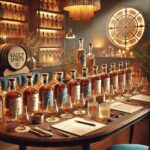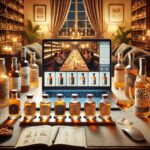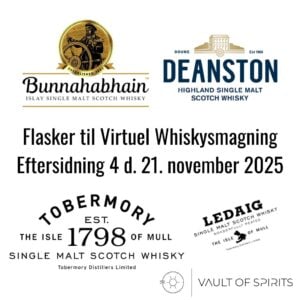Showing all 6 resultsSorted by popularity
Tasting – The Complete Guide
TL;DR: In Brief
- Spirit tastings are characterized by methodical sensory evaluation through sight, smell, and taste
- They focus primarily on experiencing spirits neat and employ a structured approach to assess quality and character
- Tastings come in several styles, including guided tastings, comparative tastings, and thematic tastings
- Best enjoyed in appropriate glassware with clean palates and can be enhanced with water drops or complementary food pairings
Disclaimer: This guide is intended for informational purposes for adults over 18 years of age. Vault of Spirits encourages responsible alcohol consumption.
Introduction to Tasting
Spirit tasting has a rich history and fascinating craft behind it. From its origins in traditional distilleries to its global popularity in modern connoisseur culture, this practice has evolved into one of the most rewarding ways to appreciate fine spirits.
This guide provides insight into the methodology, sensory analysis, and enjoyment of spirit tastings, whether you’re a novice or experienced enthusiast looking to refine your palate.
How Did Spirit Tasting Evolve?
From Past to Present
The art of spirit tasting traces back to the earliest distillation practices, when producers would sample their spirits to ensure quality and consistency.
In the 18th and 19th centuries, as commercial distillation expanded, more formal evaluation methods developed among merchants who needed to assess spirits for trade.
What began as a practical quality control measure gradually evolved into a sophisticated practice embraced by enthusiasts seeking to understand and appreciate the nuances of different spirits.
Which Historical Milestones Shaped Spirit Tasting?
The 19th century saw the emergence of dedicated tasting rooms in distilleries, particularly in Scotland and France, where visitors could sample products.
The mid-20th century brought more scientific approaches to sensory evaluation, with standardized flavor wheels and tasting vocabularies being developed for whisky, brandy, and other spirits.
The 1990s and early 2000s witnessed a renaissance in spirit appreciation, with tasting becoming democratized beyond industry professionals to embrace enthusiastic consumers.
How Have Tastings Influenced Cultural Traditions?
In Scotland, whisky tastings have become integral to cultural identity, with ceremonies and rituals developing around the proper appreciation of their national spirit.
Mexican tequila culture embraces formal tastings as a way to distinguish authentic, high-quality expressions from mass-produced products.
In Japan, whisky tastings have adopted elements from traditional tea ceremonies, emphasizing mindfulness and respect for the craft.
Why Are Tastings Popular Today?
The craft spirits movement has fueled interest in understanding what makes each spirit unique, with consumers seeking education alongside enjoyment.
Social media has transformed tastings into shareable experiences, with enthusiasts documenting their discoveries and connecting with like-minded spirits lovers worldwide.
The experience economy has elevated tastings from simple sampling to immersive events that tell stories about heritage, craftsmanship, and terroir.
How Are Spirit Tastings Conducted?
Which Equipment Is Used for Proper Tasting?
A proper spirit tasting involves specialized equipment designed to enhance the sensory experience and evaluation process.
Primary equipment:
- Tasting glasses – Tulip-shaped glasses that concentrate aromas and direct them toward the nose
- Water droppers – For precisely adding small amounts of water to open up flavors
- Spittoons – Essential for professional tastings where multiple samples are evaluated
What Is the Systematic Approach to Tasting?
Professional tastings follow a methodical process that engages all senses in sequence to fully appreciate a spirit’s character.
The process typically begins with visual assessment, noting color, viscosity, and clarity, which can reveal information about age and production methods.
Next comes nosing, where aromas are carefully analyzed in stages – first impression, deeper inhalation, and after adding a few drops of water.
Finally, tasting assesses the palate entry, development, finish, and mouthfeel, often accompanied by note-taking to document impressions.
Which Evaluation Methods Are Most Common?
Several established evaluation methods guide how spirits are professionally assessed during tastings.
Common evaluation approaches:
- Descriptive analysis – Identifying and quantifying specific flavor components
- Comparative tasting – Evaluating multiple samples against each other to highlight differences
- Blind tasting – Sampling without knowledge of brand or type to eliminate preconceptions
How Does Palate Training Develop?
The ability to discern flavors and aromas in spirits is a skill that improves with deliberate practice and experience.
Beginners often start by learning to identify broad flavor categories before developing the ability to detect more subtle nuances.
Professional tasters often use reference samples and aroma kits to train their palates to recognize specific compounds present in spirits.
Regular, focused practice with note-taking accelerates development, with most experts agreeing that palate training is a lifelong journey.
What Types of Tastings Are Available?
Where Can You Experience Professional Tastings?
Professional tastings take place in various settings, each offering unique advantages for spirit enthusiasts.
Distillery tastings provide the most authentic experience, allowing visitors to understand production methods alongside sampling.
Dedicated tasting rooms and spirits festivals offer opportunities to sample multiple brands and styles in one session.
Master classes led by industry experts combine education with tasting, providing deeper insights into production, history, and evaluation techniques.
How Do Virtual Tastings Work?
The digital era has transformed how we experience tastings, with virtual options expanding accessibility worldwide.
Participants typically receive sample kits ahead of scheduled online sessions, allowing everyone to taste the same spirits simultaneously.
Interactive elements like live Q&A with distillers, digital tasting notes, and community discussion enhance the experience beyond simply drinking at home.
Virtual platforms have democratized access to rare spirits and expert guidance that was previously available only in major cities or at distilleries.
What Makes Themed Tastings Special?
Themed tastings focus on specific aspects of spirits, creating cohesive experiences that deepen understanding.
Regional tastings explore how terroir influences spirits from particular areas, such as Islay whiskies or Jalisco tequilas.
Production-focused tastings might compare spirits made with different stills, aging methods, or grain bills to highlight technical influences.
Historical tastings feature vintage bottlings or recreations of historical recipes, offering glimpses into how spirits have evolved over time.
How Are Flights Structured?
Tasting flights arrange multiple spirits in a specific sequence designed to enhance the comparative experience.
Flights typically progress from lighter to more intense expressions, ensuring earlier samples don’t overwhelm the palate for later ones.
Professional flights often include palette cleansers between samples, such as water, plain crackers, or mild cheese.
The number of samples in a flight is carefully considered, with most experts recommending between 4-6 spirits to avoid palate fatigue.
How Do You Taste Like a Professional?
What Characterizes the Professional Tasting Approach?
Professional tasters adopt a systematic methodology that maximizes their ability to objectively evaluate spirits.
Typical aroma categories identified:
- Fruity notes – Apple, citrus, stone fruits, tropical fruits, berries
- Botanical elements – Herbs, spices, flowers, grass, vegetation
- Wood influences – Vanilla, caramel, toast, smoke, cedar, spice
How Do The Senses Work Together During Tasting?
Spirit tasting engages multiple senses simultaneously, creating a comprehensive sensory experience.
Sight provides initial information about age, cask influence, and filtration through color assessment and viscosity observation.
Smell contributes up to 80% of flavor perception, with professionals often spending more time nosing than actually tasting.
Taste and mouthfeel work together to evaluate sweetness, acidity, bitterness, body, and texture, while retronasal aromas complete the experience.
How Do You Develop Your Tasting Vocabulary?
Building a precise language to describe spirits requires practice and exposure to a wide range of flavor references.
Many professionals begin by using established flavor wheels as reference points, gradually developing their personal descriptive vocabulary.
Comparative tastings help develop the ability to articulate subtle differences between similar spirits.
Reading professional reviews and tasting notes expands vocabulary, though authenticity in personal description is always valued over pretension.
Which Factors Influence Tasting Perception?
Multiple variables can significantly affect how spirits are perceived during tastings.
Environmental factors like room temperature, ambient smells, and lighting can enhance or detract from the tasting experience.
Physiological conditions including time of day, recent meals, and individual sensitivity thresholds create personal variation in perception.
Psychological elements such as expectations, label information, and price knowledge have been scientifically proven to influence how we experience flavors.
How Should You Prepare for a Tasting?
What Is the Optimal Environment?
Creating the right setting significantly enhances the tasting experience and evaluation accuracy.
The ideal tasting environment features neutral odors, good lighting, minimal distractions, and comfortable seating.
Temperature plays a crucial role, with most experts recommending room temperatures between 60-70°F (15-21°C) for optimal aroma release.
Proper ventilation ensures aromas don’t accumulate and interfere with subsequent samples, particularly important for high-proof or heavily aromatic spirits.
Which Glassware Enhances the Experience?
Specialized glassware has been developed to maximize the tasting experience for different spirits.
The Glencairn glass, with its tulip shape and narrow rim, has become the standard for whisky tastings, concentrating aromas effectively.
Copita glasses, traditionally used for sherry, work excellently for spirits like rum and tequila where aromatic appreciation is crucial.
ISO tasting glasses provide a standardized format for professional evaluations, while snifters are preferred for brandies and aged rums.
How Should You Prepare Your Palate?
Palate preparation is essential for maximizing sensitivity during tastings.
Avoid strongly flavored foods, coffee, tobacco, and fragranced products for at least an hour before serious tastings.
Hydration is crucial, with water being the ideal companion throughout the tasting process.
Some professionals practice brief palate calibration with diluted neutral grain spirit or very mild samples before beginning evaluations.
What Should You Know About Tasting Notes?
Recording impressions effectively enhances the learning experience and helps track palate development.
Structured tasting notes typically include sections for appearance, nose, palate, finish, and overall impression.
Digital apps and specialized notebooks provide frameworks for consistent documentation across multiple tastings.
The most valuable tasting notes balance objective description with personal reaction, avoiding overly technical language that obscures genuine impression.
What Are Common Tasting Techniques?
How Should You Approach Nosing?
Proper nosing technique reveals the complex aromatics in spirits without overwhelming the senses.
The Kentucky Chew
Technique: Take a small sip, chew it around your mouth to coat all taste receptors, then swallow or spit
Purpose: Maximizes exposure to all parts of the palate and activates retronasal olfaction
Origin: Popularized by bourbon master distillers in Kentucky
Which Tasting Methods Enhance Flavor Perception?
Several approaches can help identify and appreciate the full complexity of spirits during tastings.
The addition of a few drops of room-temperature spring water often “opens up” spirits, releasing volatile compounds and reducing the numbing effect of alcohol.
Sequential tasting involves revisiting the same spirit multiple times throughout a session to track how it evolves with air exposure.
Comparative tasting places similar spirits side by side to highlight subtle differences that might otherwise go unnoticed in isolation.
How Do You Manage High-Proof Spirits?
High alcohol content presents specific challenges during tastings that require adaptation of technique.
For spirits above 50% ABV, professionals often employ graduated approach nosing – starting with the nose further from the glass and gradually moving closer.
Controlled dilution with precise water additions can bring overproof spirits to more manageable strengths without losing essential character.
Palate rest between high-proof samples becomes even more crucial to prevent sensory fatigue and maintain evaluation accuracy.
What Role Does Water Play?
Water is perhaps the most important tool in the professional taster’s arsenal.
As a palate cleanser, water resets taste buds between samples and maintains hydration throughout tasting sessions.
When added to spirits in controlled amounts, water can transform the aromatic profile by reducing alcohol dominance and releasing bound flavor compounds.
The quality of water matters significantly, with neutral pH spring water preferred over tap water that may contain chlorine or other interfering elements.
How Can You Enhance Your Tasting Experience?
Which Food Pairings Complement Tastings?
Strategic food pairings can enhance appreciation during educational tastings without overwhelming the spirits.
Neutral palate cleansers like water crackers or mild bread help reset the palate between samples.
Dark chocolate pairs exceptionally well with aged spirits like whisky, rum, and cognac, bringing out complementary flavor notes.
For exploration tastings, foods containing similar flavor compounds to the spirits can highlight specific notes – like almonds with sherry-aged whisky or citrus with gin.
How Can You Document Your Tasting Journey?
Recording your tasting experiences creates valuable personal reference and tracks palate development.
Physical tasting journals provide tactile connection and permanent record, while specialized apps offer organizational advantages and community sharing.
Photography of samples in proper lighting creates visual context that helps recall specific experiences.
Voice recording immediate impressions captures spontaneous reactions that might be lost in more formal written notes.
What Makes Group Tastings Special?
Shared tasting experiences offer unique benefits beyond individual evaluation.
Group discussion reveals how differently people perceive the same spirit, expanding everyone’s understanding of possible interpretations.
Structured formats like round-robin commentary or blind voting add engaging elements to social tastings.
Combined knowledge in enthusiast groups often provides historical context or technical insights that enrich the tasting experience.
How Can You Develop Advanced Tasting Skills?
Moving beyond basics to expert-level tasting requires dedicated practice and expanded knowledge.
Regular comparison of benchmark expressions creates reliable reference points for evaluating new spirits.
Studying production techniques helps connect specific flavors to their sources in fermentation, distillation, and maturation processes.
Pursuing formal education through certifications like WSET spirits qualifications provides structured development of systematic tasting ability.
What Should You Know Before Attending a Tasting?
What Details Should You Consider When Choosing a Tasting?
Not all tastings offer the same experience, so selecting the right format matters significantly.
Consider the expertise level of the host, as knowledgeable presenters dramatically enhance educational value.
Review the spirits selection to ensure alignment with your interests, whether exploring new categories or deepening knowledge in favorites.
Evaluate the setting and group size, as intimate gatherings allow for more interaction while larger events might offer greater variety.
What Can You Expect at Different Price Points?
Tasting experiences vary considerably across price ranges, each offering distinct value propositions.
Entry-level tastings ($25-50) typically feature introductory selections with basic education, perfect for beginners.
Mid-range experiences ($75-150) often include premium expressions and more detailed production information, ideal for enthusiasts seeking depth.
Premium tastings ($200+) might feature rare or vintage spirits, master distiller presentations, or exclusive venue access for serious aficionados.
How Should You Behave at a Professional Tasting?
Tasting etiquette ensures everyone can fully enjoy and benefit from the experience.
Avoid wearing fragrances that can interfere with everyone’s olfactory perception.
Respectful questioning adds to group learning, while lengthy personal stories or dominating conversation detracts from the experience.
For serious evaluation tastings, observe quiet periods during nosing and initial tasting before discussion begins.
How Can You Get Maximum Value from a Tasting?
Strategic approaches can significantly enhance what you gain from organized tastings.
Take notes during the experience, focusing on personal impressions rather than trying to match the presenter’s descriptions.
Ask specific questions about production elements that influence flavors you’re detecting.
When appropriate, request information about availability of favorites from the tasting for future purchase.
Which Tasting Formats Do We Recommend?
What Works Best for Beginners?
Newcomers to spirit tasting benefit most from formats that provide clear guidance and accessible experiences.
Introductory flight tastings with 3-4 expressions showcasing fundamental style differences create strong foundational understanding.
Guided tastings with detailed explanation of production basics and systematic tasting approach build crucial skills.
Category-focused tastings (all bourbon, all gin) allow deeper exploration without overwhelming variety.
What Will Impress Enthusiasts?
Experienced tasters seek deeper challenges and educational opportunities in their tasting experiences.
Vertical tastings exploring age progression within a single brand reveal maturation effects with remarkable clarity.
Technical tastings focusing on production variables like yeast strains, barrel chars, or still designs satisfy analytical curiosity.
Blind comparative tastings challenge preconceptions and develop genuine evaluation skills beyond brand influence.
Which Formats Are Most Educational?
Certain tasting approaches maximize learning potential for participants serious about developing expertise.
Component tastings isolate specific elements (like various wood types) to train recognition of their contribution to finished spirits.
Deconstructed tastings present new-make alongside progressively aged versions to demonstrate maturation development.
Comparative regional tastings highlight how terroir and tradition create distinctive expressions within a single category.
Where Can You Find the Best Value Experiences?
Quality tasting experiences don’t always require premium pricing.
Distillery tours often include comprehensive tastings at surprisingly reasonable rates compared to standalone events.
Spirits festivals offer exceptional variety-to-cost ratio, though with less individual attention than smaller formats.
Retailer-hosted tastings frequently provide excellent value, as they’re partially subsidized to encourage subsequent purchases.
Frequently Asked Questions
What Is a Spirit Tasting?
A spirit tasting is a structured sampling of distilled alcoholic beverages to evaluate their appearance, aroma, flavor, and finish. Tastings can be educational, evaluative, or recreational, and range from formal assessments to social experiences.
How Should You Taste Spirits Properly?
Proper spirit tasting involves examining appearance first, then nosing carefully to assess aromas, followed by tasting a small amount to evaluate flavor and mouthfeel. The process is deliberate and attentive, often involving the addition of small amounts of water to reveal more subtle characteristics.
What Characterizes a Good Tasting?
A good tasting features appropriate glassware, a comfortable environment free from competing aromas, knowledgeable guidance, well-selected spirits in a thoughtful sequence, and sufficient time to appreciate each sample. Quality water and neutral palate cleansers enhance the experience.
Where Can You Attend Tastings?
Spirits tastings are available at distilleries, dedicated tasting rooms, spirits festivals, specialty bars and retailers, private clubs, and through virtual platforms. Many producers and educators now offer home tasting kits paired with online guided experiences for remote participation.







